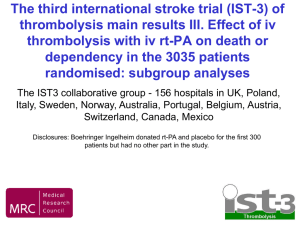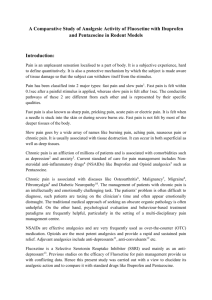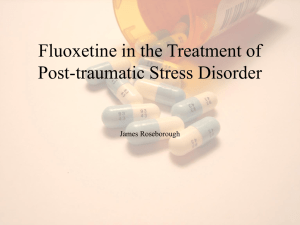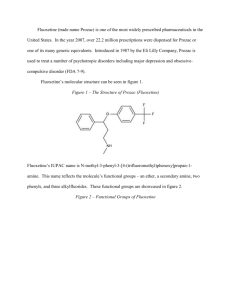AFFINITY trial Assessment oF FluoxetINe In sTroke recoverY
advertisement
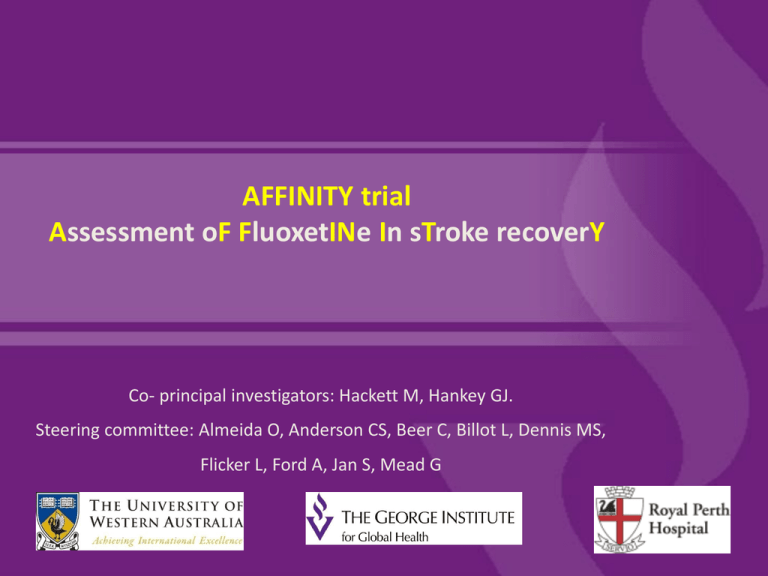
AFFINITY trial Assessment oF FluoxetINe In sTroke recoverY Co- principal investigators: Hackett M, Hankey GJ. Steering committee: Almeida O, Anderson CS, Beer C, Billot L, Dennis MS, Flicker L, Ford A, Jan S, Mead G The burden of disability due to stroke • 4th leading cause of global disease burden • 16 million 1st-ever events • 51 million disability-adjusted life years • 5.7 million deaths • 50% of stroke survivors have long-term residual disability. – How can we improve recovery & reduce disability after stroke? Fluoxetine Animal studies suggest fluoxetine is effective ? directly improves motor function ? indirectly improves motivation and attention FLAME trial (Lancet Neurology, 2011;10:123-130) • Fluoxetine on Motor Rehabilitation after ischaemic stroke • RCT: 118 with acute ischaemic stroke & unilateral motor weakness • Intervention: 20 mg fluoxetine daily, 3 months vs. placebo FLAME trial: Modified Rankin score at 90 days mRS 0-2: 26.3% fluoxetine vs 8.9% placebo OR = 3.8, 95% CI 1.2 to 10.7 FLAME trial: Fugl Meyer Motor scores Adjusted mean Fugl-Meyer motor scale (FMMS) total scores at days 0, 30, and 90 Error bars represent 95% CI Rationale for a new trial FLAME results promising, however: • ? Internal validity (Random error) – only 57 pts assigned fluoexetine vs 56 placebo – Wide 95% CI of estimates (Independency OR = 3.8, 95% CI 1.2 to 10.7) • ? External validity (generalisability) We need to know: • Does fluoxetine really work and is it safe in elderly stroke pts? • Are the results generalisable to an Australian population? • Do the benefits persist after treatment has ceased? Adverse outcomes of SSRIs in older people BMJ 2011; 343: d4551 • • • • • Design: Setting: Subjects: Follow-up: Outcomes: • Analysis: Population-based cohort study 570 general practices in UK 60,746 people > 65 years with depression 364 days median (91-1029 IQR) Death, attempted suicide/self harm, stroke, MI, falls, fractures, upper GI bleeding, seizures, hyponatraemia Adjusted hazard ratios of outcomes with SSRIs vs when antidepressants not used. Adverse outcomes of SSRIs in older people BMJ 2011; 343: d4551 Outcome HR (95% CI) Absolute risk (%/yr) (Fluoxetine vs no antidepressant) • • • • • • • • • Mortality Falls Fractures Stroke/TIA MI Attempted suicide/self-harm Hyponatraemia Upper GI bleed Epilepsy/Seizures 1.54 1.66 1.58 1.17 1.15 2.16 1.52 1.27 1.83 (1.48-1.59) (1.58-1.73) (1.48-1.68) (1.10-1.26) (1.04-1.27) (1.71-2.79) (1.33-1.75) (1.07-2.40) (1.49-2.26) 4.4% (11.4% vs 7.0%) 2.1% (5.6% vs 3.5%) 1.0% (2.8% vs 1.8%) 0.4% (2.6% vs 2.2%) 0.3% (1.3% vs 1.0%) 0.3% (0.5% vs 0.2%) 0.2% (0.5% vs 0.3%) 0.1% (0.5% vs 0.4%) 0.1% (0.3% vs 0.2%) Assessment oF Fluoxetine IN sTroke recoverY (AFFINITY) trial Primary aim 1◦ To determine if : fluoxetine, 20 mg, once daily, started 2-15 days after acute stroke, and continued for 6 months, improves recovery & functional ability. Secondary aims 2◦ To determine if fluoxetine… – Improves at 6 months • • • • survival, mood (PHQ-9), cognitive function (TICSm), HRQoL (SF-12), – Reduces at 6 months • fatigue (SF-36 vitality domain) – Is safe – Reduces the cost of health and social care – Has persisting effects at 12 months on: • functional ability, survival, mood, cognitive function, HRQoL, and fatigue Inclusion criteria • • • • • Male or female ≥ 18 years of age Clinical diagnosis of stroke; onset 2-15 days ago Imaging consistent with ICH or ischaemic stroke Neurological deficits at randomisation which are severe enough to warrant Rx (pt or carer perspective) Exclusion criteria • History of: • • • • • • • • • • • • • • • Epileptic seizures Bipolar disorders Drug overdose Attempted suicide Allergy to fluoxetine Current or recent (<5/52) Rx with MAOI or pimozide Current or recent (<1/12) depression requiring Rx with SSRI Current Rx with other antidepressants unless agree to discontinue on randomisation Unlikely to be contactable or available for follow-up over 12 months Unlikely to survive 12 months (e.g. life-threatening illness) SAH (except if 2◦ to ICH) Pregnant or breast feeding, female of child bearing age not on adequate contraception Hyponatraemia (sodium < 130 mmol/l) Hepatic impairment (ALT < 120 U/L) Renal impairment (Creatinine > 220 micromol/L) Trial recruitment and assessments: from the patients’ perspective • Approached by clinician who checks inclusion and exclusion criteria and discusses rationale for fluoxetine vs placebo trial • Receives patient information leaflet and verbal explanation • Time to consider whether to take part • Signs informed consent form (or next of kin) • Information entered into trial database online (www.affinitytrial.org) and randomisation code assigned Randomisation • Web-based, central randomisation service – http://affinitytrial.org • Rx allocation ratio 1:1 • Minimisation algorithm: – Time since stroke onset (2-8 vs 9-15 days) – Presence of a motor deficit – Presence of aphasia – Probability of survival free of dependency at 6 months (0-15% vs 16-100%) (i.e. allocates each patient to the treatment group that leads to the least difference between the two groups with respect to these features) Intervention • Fluoxetine 20 mg/day or Placebo one/day – Oral – Double-blind – 6 months Adverse effects of newer antidepressants and suggested management. BMJ 2012; 344: d8300. • • • • • • • • • • Adverse effect Comment Dizziness < 10% Management Check BP standing and lying; symptoms may improve over time; Decrease dose or change treatment. Ensure adequate fluid intake Sedation Not common May be desirable; May improve over time. Change time of dosing and treatment Dry mouth Probably dose related Tolerance may develop; change treatment; Sugarless gum or saliva substitutes Sexual dysfunction Common Reduce dose, wait for improvement, switch to a different antidepressant, or consider sildenafil Insomnia Common Try to distinguish from insomnia caused by depression Change time of dosing (earlier or later may help), improve sleep hygiene, try a different antidepressant, or short course of benzodiazepine, zopiclone, or low dose trazadone Suicidal thoughts Age < 30 Review often (within a week of starting Rx and until no longer needed). No evidence that asking about suicide increases likelihood of self- harm. Prescribe small amounts of medication. Anxiety Often when starting Rx Consider using a benzodiazepine for no longer than two weeks Hyponatraemia A problem in the elderly Check sodium before and after starting treatment Consider changing to mirtazapine if it becomes problematic Serotonin syndrome Confusion/agitation, Stop the antidepressant Autonomic instability,and Hydration, Rx of hyperthermia, and benzodiazepines Neuromuscular hyperactivity Consider cyproheptadine or chlorpromazine in severe cases Discontinuation syndrome Decrease dose over four weeks. Warn the patient Management of depression • Consider non-pharmacological treatments – Advise an increase in social outlets and regular exercise – Consider referral to a clinical psychologist. • Clinical psychology can be accessed through the Medicare Better Access initiative free of charge to Australian residents & citizens for up to 12 sessions/year (http://www.health.gov.au/internet/main/publishing.nsf/Content/mental-ba-over • Consider adding 10 mg of fluoxetine to the participant’s trial medications and increasing this further to 20 mg after 4-6 weeks if ineffective. – This would mean that some participants would potentially be on 40 mg of fluoxetine a day. This dose has been shown to be effective and safe. • Combination therapy (using >2 antidepressants simultaneously) should best be avoided in view of the risk of serotonergic syndrome, especially if using another SSRI. – If choose to initiate possible combination therapy, use a non-serotonergic antidepressant such as reboxetine or one with less serotonergic activity such as mirtazapine • Consider referral to a specialist psychiatrist Outcome measures • Primary: simplified modified Rankin score at 6 months – Stroke 2010; 41: 1048-50; Stroke 2011; 42: 2276-9; Stroke 2012; 43: 851-3. • Secondary – – – – – – – Adherence to medication New clinical diagnosis of depression Survival Depression (PHQ 9; 9 questions) Cognition (TICSm; 13 questions) Fatigue (Vitality score of SF-36; 4 questions) Resource use (3 questions) Optional – Overall health status: Stroke impact score (59 items, 8 domains) – Health-related quality of life (SF 12; 12 questions) Sample size calculations • Expect % of independent participants (mRS 0-2) in intervention group to: – increase by 7.5% absolute percentage points (from 50% to 57.5%) – increase by 15 relative percentage points, – odds ratio of 1.35 • (cf. FLAME: OR = 3.8, 95%: CI 1.2 to 10.7) Expected distributions of mRS scores at 6 months (end of fluoxetine) mRS score 0 1 2 3 4 5 6 Control group 0.10 0.20 0.20 0.15 0.10 0.10 0.15 Intervention group 0.13 0.24 0.21 0.14 0.09 0.08 0.12 Trial design: Flow of participants and assessments 1,580 patients Informed consent and trial specific screen and baseline assessment Central randomisation 2 to 15 days post-stroke Intervention group (n=790) Control group (n=790) 1 month on-intervention assessment 3 month on-intervention assessment and dispensing End of 6-month intervention assessment 6-month off-intervention (12 month) assessment Collaborators (UK FOCUS) Prof Martin Dennis Dr Gillian Mead • Larger, similar trial • FOCUS pilot phase – Funded by The Stroke Association – Protocol funded by NIHR Stroke Research Network • FOCUS main phase – Funding application to NIHR HTA • Planned prospective meta-analysis AFFINITY/FOCUS joint analyses • FOCUS aims to recruit 3000 • If we complete both FOCUS and AFFINITY and enrol 4500 patients we could reliably detect a 4.4% absolute increase in mRS 0-2. We welcome interested collaborators Disability at end of Rx Disability at end of Rx, by depression or not at randomisation



